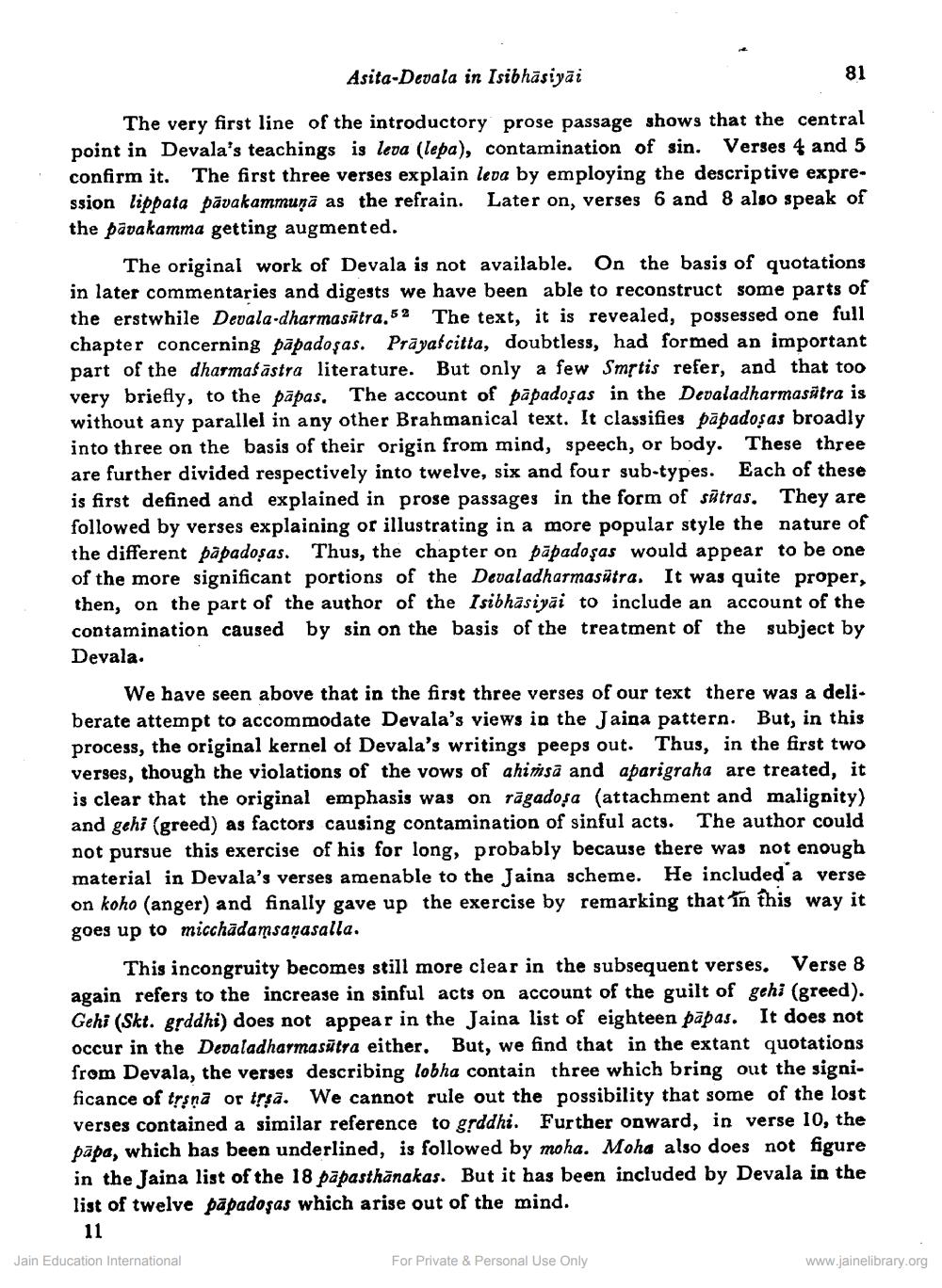Book Title: Asita Deval in Isibhasiyai Author(s): Lallan Gopal Publisher: Z_Aspect_of_Jainology_Part_3_Pundit_Dalsukh_Malvaniya_012017.pdf View full book textPage 8
________________ Asita-Devala in Isibhāsiyāi 81 The very first line of the introductory prose passage shows that the central point in Devala's teachings is leva (lepa), contamination of sin. Verses 4 and 5 confirm it. The first three verses explain leda by employing the descriptive expression lippata pāvakammunā as the refrain. Later on, verses 6 and 8 also speak of the pavakamma getting augmented. The original work of Devala is not available. On the basis of quotations in later commentaries and digests we have been able to reconstruct some parts of the erstwhile Devala-dharmasūtra.52 The text, it is revealed, possessed one full chapter concerning pāpadosas. Prāyatcitta, doubtless, had formed an important part of the dharmaśāstra literature. But only a few Smstis refer, and that too very briefly, to the pāpas. The account of pāpadosas in the Devaladharmasätra is without any parallel in any other Brahmanical text. It classifies pāpadosas broadly into three on the basis of their origin from mind, speech, or body. These three are further divided respectively into twelve, six and four sub-types. Each of these is first defined and explained in prose passages in the form of sūtras. They are followed by verses explaining or illustrating in a more popular style the nature of the different papadosas. Thus, the chapter on pāpadoşas would appear to be one of the more significant portions of the Devaladharmasūtra. It was quite proper, then, on the part of the author of the Isibhāsiyāi to include an account of the contamination caused by sin on the basis of the treatment of the subject by Devala. We have seen above that in the first three verses of our text there was a deliberate attempt to accommodate Devala's views in the Jaina pattern. But, in this process, the original kernel of Devala's writings peeps out. Thus, in the first two verses, though the violations of the vows of ahimsa and aparigraha are treated, it is clear that the original emphasis was on rāgadosa (attachment and malignity) and gehi (greed) as factors causing contamination of sinful acts. The author could not pursue this exercise of his for long, probably because there was not enough material in Devala's verses amenable to the Jaina scheme. He included a verse on koho (anger) and finally gave up the exercise by remarking that in this way it goes up to micchādamsanasalla. This incongruity becomes still more clear in the subsequent verses. Verse 8 again refers to the increase in sinful acts on account of the guilt of gehi (greed). Gehi (Skt. grddhi) does not appear in the Jaina list of eighteen papas. It does not occur in the Dedaladharmasūtra either. But, we find that in the extant quotations from Devala, the verses describing lobha contain three which bring out the significance of trşņā or trša. We cannot rule out the possibility that some of the lost verses contained a similar reference to grddhi. Further onward, in verse 10, the pāpa, which has been underlined, is followed by moha. Moha also does not figure in the Jaina list of the 18 papasthānakas. But it has been included by Devala in the list of twelve papadosas which arise out of the mind. 11 Jain Education International For Private & Personal Use Only www.jainelibrary.orgPage Navigation
1 ... 6 7 8 9 10 11 12 13 14
